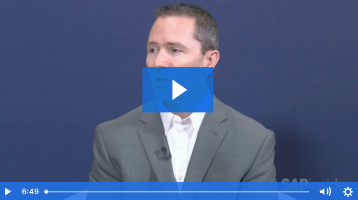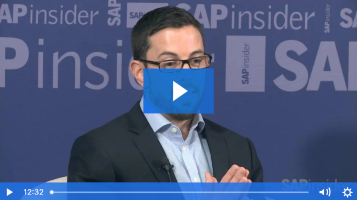Going Under the Hood of SAP C/4HANA
When it comes to companies implementing CRM platforms — it’s hard to talk about SAP C/4HANA without talking about Salesforce.
Salesforce has long been an industry leader when it comes to sales force automation (SFA). SAP, however, claims that it takes a broader, customer-focused approach with its customer experience solution suite. While Salesforce can be considered best-of-breed (especially its SFA module), SAP offers a much more comprehensive enterprise CRM solution, said Roberto Kirsten, Partner, Customer Experience Strategy Consulting, at Lydian Global Business Services.
One area where SAP may have been lagging in the past is “look and feel”, but times have changed. “I think C/4HANA is a game-changer. With Hybris and now the evolution to C/4HANA, SAP is finally getting the look and feel right,” Kirsten said. “The key here is personalization and conversational UI. SAP finally got the user interface to a point where it’s very light, tile-based personalize-able including dashboards and KPIs, bringing decision power to users in a flexible and unprecedented way.”
“I think not only with C/4HANA, but in the product strategy that SAP has always had for CRM, in my opinion is the only product that you can call enterprise CRM,” Kirsten said. Other solutions are narrower in focus, or solve very specific problems. “SAP is the only one who offers it all under one hood — from event creation to marketing to sales to customer service integrated and powered by analytical engine, machine learning and IOT — all while leveraging the same data model. Everything is very nicely integrated, from back to front-office.”
SAP C/4HANA was introduced last June, and customers have a lot of questions. “I spend a lot of time educating clients on what C/4HANA is,” said Kirsten.
After speaking with Kirsten, SAPinsider offers a few takeaways for insiders and questions you might want to consider:
- What is the new and old functionality SAP offers through SAP C/4HANA?
“It’s not just rebranding,” Kirsten said. Kirsten said one of the main questions he gets is about Hybris, because Hybris was a “rock star in the CRM space for commerce.” “The clients are asking if this is a new product or if Hybris is a part of it,” Kirsten said. In fact, former Hybris solutions now fall under the SAP C/4HANA umbrella. For example, SAP Hybris Cloud is now under SAP Sales Cloud and SAP Hybris Commerce is now SAP Commerce Cloud. Additionally, SAP C/4HANA features new functionalities stemming from the SAP acquisitions of CallidusCloud, Coresystems, and Gigya. Ask your SAP rep or implementation partner to confirm whether some of your favorite old solutions are part of the new platform, as well as investigate the new functionality that is available with your subscription.
- Would it be better to focus on one solution, or a stronger overall platform?
You don’t have to adopt the full SAP C/4HANA suite at once (and most solutions are available on premise in addition to cloud). Compare individual solutions and decide if you prefer to focus on one area or would rather have a more comprehensive platform for customer service. Kirsten said that if you look at some of SAP’s products in the suite individually they might not look like the most exciting ones, but “SAP is the only product that offers very comprehensive customer touch point processes.” SAP has everything under one roof and strong integration of the various customer touchpoints, he said. “However, clients don’t need to deploy everything at once and a smarter strategy is to develop a roadmap earlier on focusing on small deployments that are part of a larger Customer Experience strategy,” he said, whether on mobile, cloud, on-premise or hybrid. “The SAP platform puts everything you need to serve the customer at the point of service.”
- How is the user experience?
Although SAP C/4HANA does not have a fully harmonized UI yet, it is a significant evolution from older releases. “While back-end applications can — and should — be more rigid and process-oriented, front-end apps need to be more agile, flexible and easily extensible. Neither SAP nor any other software company can deliver out-of-the-box applications that fully support customer processes for all needs in all industries. However, SAP Fiori front-end, which allows further extension of the standard application, can bridge the gap for companies that need additional functionality. Fiori is built on the concept of personalization and offers a simplified user experience for SAP applications,” Kirsten said. SAP Fiori supports a mobile-first framework, which is a key competitive advantage with today’s consumers. “If you look at customers’ typical buying behavior before iPhones, the process used to be linear and more predictable,” Kirsten said. “Now, clients can start searching products on their phone, transition to an iPad to look at competitor’s products, and close the deal on a computer. The behavior of clients today is not linear.”
- How long does it take to implement?
“Because SAP has been a dominant ERP solution for so long, known for improving back-office functions, their success has also been their worst enemy in the CRM space. This seems to be one of the reasons a lot of clients have that old-fashioned mentality of a monolithic and inflexible product,” Kirsten said. “They still don’t see SAP as innovator and able to offer agile, easy and intuitive applications … so I think what clients are asking and I hear this all the time is, ‘Is it really as fast to implement as they claim’?” Kirsten said SAP has embraced newer technology and has more agile deployment options. “You don’t have to go live in a traditional lifecycle,” he said. “You can do things incrementally with deployment cycle durations ranging from weeks to a few months.”
- How important are analytics to you?
While many companies use Salesforce for SFA, one area where SAP is dominating discussions is marketing, where analytics tools are helping companies implement successful customer strategies. “SAP has greatly improved marketing functionality that supports better client strategies with the use of customer behavior intelligence and predictive analytics. The days of thinking of CRM purely as a transactional application are over. Everybody is wondering — how they can understand their clients’ behavior – for that you need a harmonized/central data model, powerful but easy to use analytics tools and an intuitive UI — SAP has all that,” Kirsten said. And with SAP C/4HANA, the analytics engine is integrated — you don’t have to know BI and build InfoCubes.





